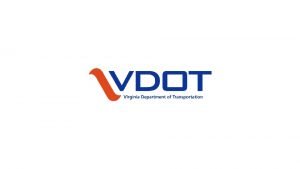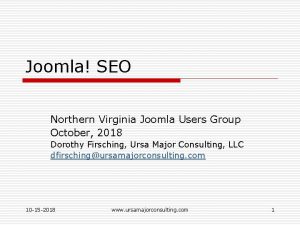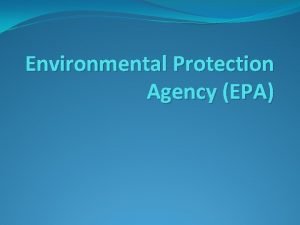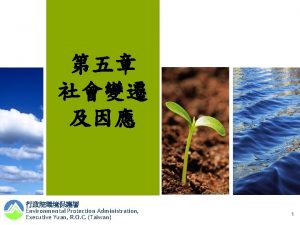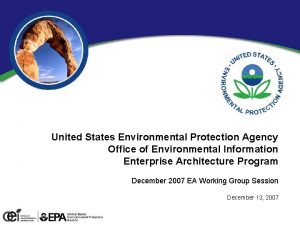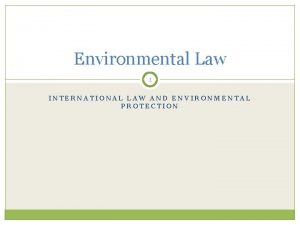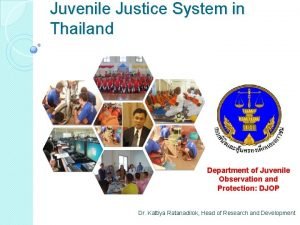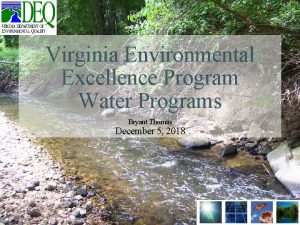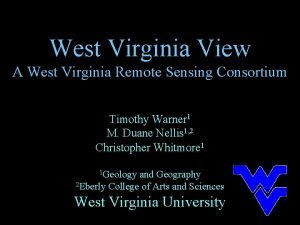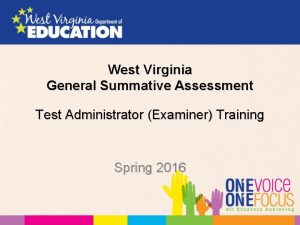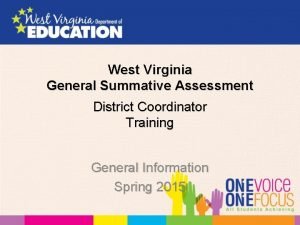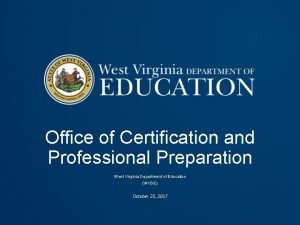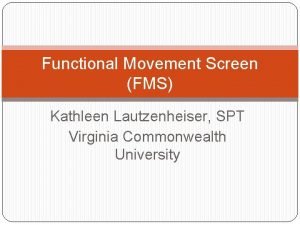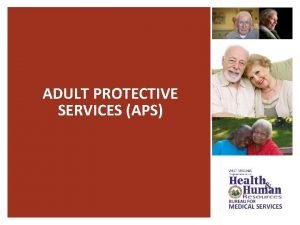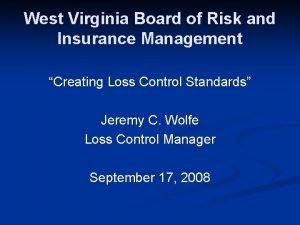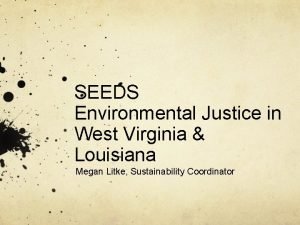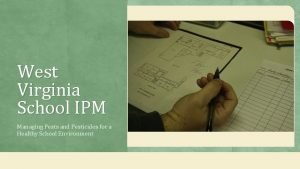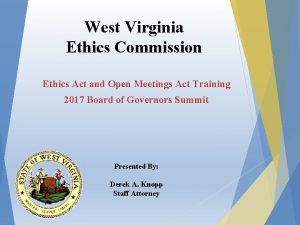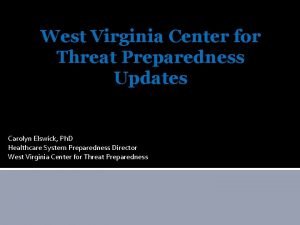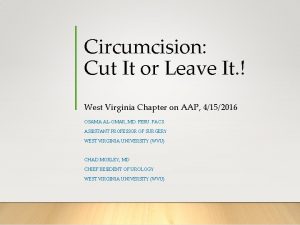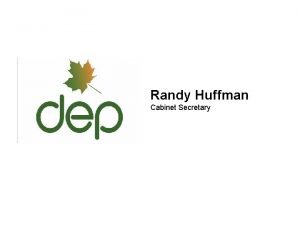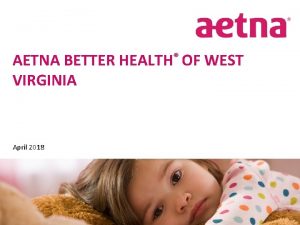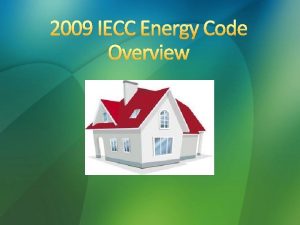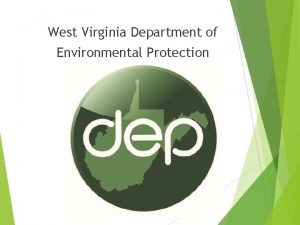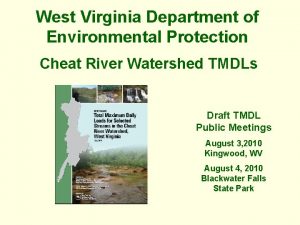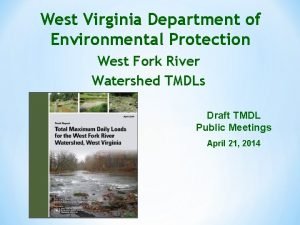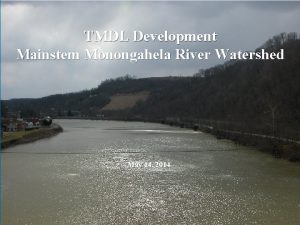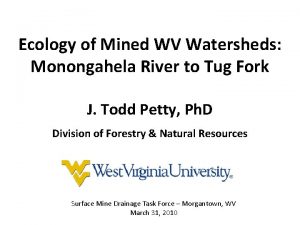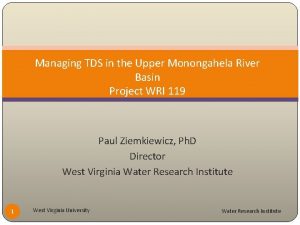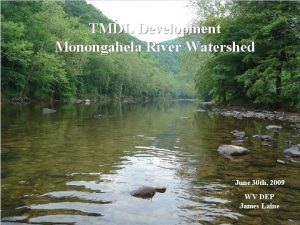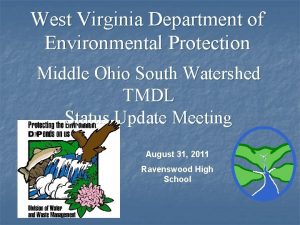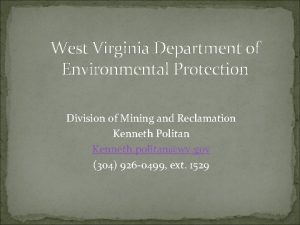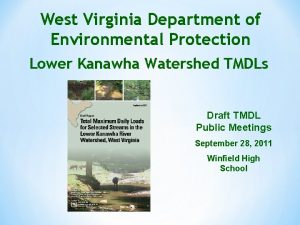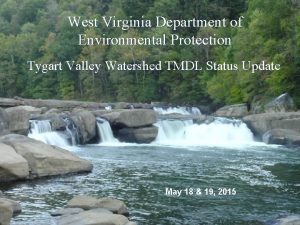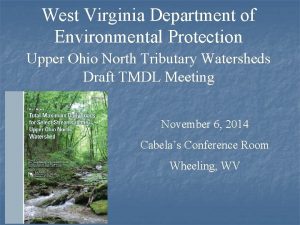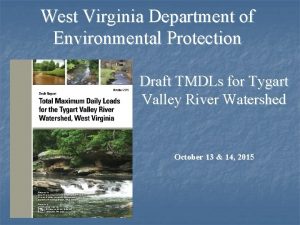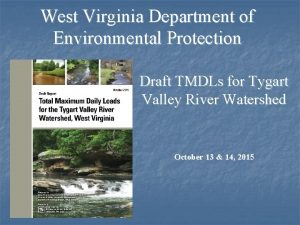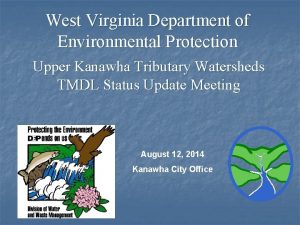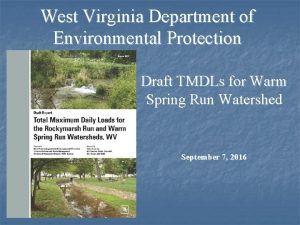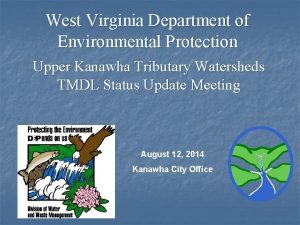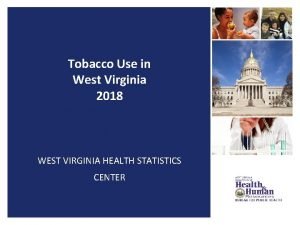West Virginia Department of Environmental Protection Monongahela River


































- Slides: 34

West Virginia Department of Environmental Protection Monongahela River Watershed TMDLs Draft TMDL Public Meetings August 20, 2013

Agenda TMDL/ water quality standards recap Overview of this TMDL effort Explanation/demonstration of electronic documents, spreadsheets, tools Questions and Answers

What’s a TMDL? “Total Maximum Daily Load” How much pollutant a stream can receive and remain healthy A Pollution Budget – prescribes reduction of pollutants (where needed) that result in the restoration of an impaired stream TMDL development is required by the Clean Water Act for all streams impaired by a pollutant

What’s an Impaired Stream? Stream that doesn’t meet water quality standards WV Water Quality Standards are codified in 47 CSR 2 Standards include “Designated Uses” for WV waters and the criteria to protect those uses Water Quality Criteria can be numeric or narrative

Numeric Criteria of Concern Dissolved Aluminum Aquatic Life Not to exceed 750 ug/l as a 1 hour average concentration more than once in a three year period Not to exceed 750 ug/l (warmwater) nor 87 ug/l (troutwater) as a 4 day average concentration more than once in a three year period Chloride Aquatic Life/ Water Contact Recreation/ Public water Supply Not to exceed 230 mg/l as a 4 day average concentration more than once in a three year period Not to exceed 860 mg/l as a 1 hour average concentration more than once in a three year period Public Water Supply/Contact Recreation - 250 mg/l

Criteria of Concern Fecal Coliform Water Contact Recreation/Public Water Supply Shall not exceed 200 counts/100 ml as a monthly geometric mean (5 samples/month) Nor to exceed 400 counts/100 ml in more than 10% of samples in a month Total Iron Aquatic Life/Public Water Supply Not to exceed 1. 5 mg/l (warmwater) or 1. 0 mg/l (troutwater) as a 4 day average concentration more than once in a three year period Public Water Supply - 1. 5 mg/l

Criteria of Concern *Total Manganese *Public Water Supply *Not to exceed 1. 0 mg/l within a 5 mile zone immediately upstream of a water supply used for public or private consumption (Brand Run) p. H Aquatic Life/Water Contact Recreation/Public Water Supply No values below 6. 0 nor above 9. 0.

Criteria of Concern Selenium Aquatic Life/Public Water Supply Not to exceed 20 ug/l as a 1 hour average more than once in a three year period Not to exceed 5 ug/l as a 4 day average concentration more than once in a three year period Public Water Supply - 50 ug/l

Narrative Criteria Previous 47 CSR 2 - 3. 2. i Assessment Based on Benthic Macroinvertebrates West Virginia Stream Condition Index (WVSCI) Standardized method for assessing benthic macroinvertebrates (aquatic bugs) WVSCI stream scores normalized to 0 - 100 range Streams scoring less than the 60. 6 threshold value labeled as “impaired” and placed on the 303(d) list Streams listed as impaired slated for TMDLs “Biologically Impaired” streams evaluated for source/s of impairment during the TMDL development process (Stressor Identification Process)

Narrative Criteria 2012 Legislative Changes *Senate Bill 562 passed by the 2012 West Virginia Legislature amended the WV Water Pollution Control Act *Requires “evaluation of the holistic health of the aquatic ecosystem” *Requires DEP to develop and secure legislative approval of new rules to interpret 47 CSR 2 -3. 2. i *Section 22 -11 -7 b : http: //www. legis. state. wv. us/wvcode/Chapter. E ntire. cfm? chap=22&art=11 *No biological TMDLs are part of this effort

TMDL = S WLA + S LA + MOS S = “sum of” WLA = “wasteload allocations” LA = “load allocations” MOS = “margin of safety” WLAs - pollutant loads for “point sources” Discharge from point Need NPDES permit LAs - pollutant loads for “nonpoint sources” and background Precipitation and runoff No permit required

TMDL Development History Project Timeline: Proposed streams advertised for public comment April 2009 Initial Public Meetings (TMDL Intro) June 2009 Watershed Monitoring and Source Tracking July 2009 - June 2010 Draft TMDL Public Meeting Today

Impaired Waters 153 named streams – See Table 3 -3 beginning on page 11 of Draft Report for a complete list of streams and impairments

Modeling

Modeling MDAS (Mining Data Analysis System) Fecal Coliform, iron, chlorides, Mn, Al and p. H Can handle point and nonpoint sources (representation and allocation) Recognizes exposure duration and exceedence frequency components of criteria

Modeling 28 TMDL watersheds 370 subwatersheds Monongahela River mainstem is not part of this effort

Baseline Condition Design precipitation period Hourly precipitation data for a six-year period Design period includes wet and dry years Applied to present day land uses Permitted discharges equal to permit limits

TMDL Condition Existing pollutant sources reduced such that TMDL endpoints are achieved in each modeled subwatershed recognizing Criteria value, duration and exceedence frequency Margin of safety

Margin of Safety Required component of TMDLs Explicit 5% used in most TMDLs TMDL endpoints for numeric criteria are 95% of criterion value (ex. 1. 425 mg/l for 1. 5 mg/l criterion)

Baseline/TMDL Example

Pollutant Sources (Iron) Streambank erosion Abandoned Mine Lands Upland Sediment Sources Harvested Forest Oil and Gas Agriculture Urban Residential outside MS 4 areas Roads Active Mining MS 4 areas Construction Stormwater General Permits

Iron Reduction Strategy Streambank Erosion reduced to reference stream loadings Sediment sources, including AML, set to iron loadings equivalent to 100 mg/l TSS Mining point sources and AML seeps set to WQ at end of pipe

Iron Reduction Strategy continued Future growth for Construction Stormwater throughout the impaired watershed drainage was initially allocated at 2. 5% of subwatershed area * If further reductions needed then based on sensitivity analysis: * CSGP areas were reduced incrementally from 2. 5 to 0. 5 % and/or * Dominant land sources were reduced incrementally below 100 TSS threshold until endpoint is met or 70 mg/l TSS * If further reductions needed at subwatershed pour points then CSGP areas were reduced to 0% *Nonpoint source reductions did not result in LA lower than background concentrations *Point Source reductions did not result in WLA more stringent than water quality standards end of pipe

Fecal Pollutant Sources & Strategy Fecal Coliform STP effluents represented at existing limits (200/400) Failing/nonexistent on-site sewage systems – 100% reduction Combined Sewer Overflows (CSOs) - reduced to water quality criteria (200/400 cts) Sensitivity Analysis based reductions Urban runoff Agriculture

Chloride Sources & Strategy *Sources include: * Permitted mining discharges * MS 4 and Multi-Sector Stormwater General Permits in two watersheds (Popenoe Run & Unt/West Run RM 0. 91) – violations noted in Pre-TMDL sampling in winter months * Runoff from urban impervious lands outside MS 4 area *Reductions Strategy * Mining outlets – WLA equal to criteria (230 mg/l) at end of pipe * MS 4 areas and Multi-Sector Stormwater General permits in Popenoe Run and Unt/West Run – WLA reduced as needed to meet TMDL endpoint instream * Unt/West Run RM 0. 91 – nonpoint source contribution from urban impervious lands reduced commensurate w/MS 4

Manganese Sources & Strategy *Brand Run is the only stream impaired for Manganese *Only sources contributing significant loadings are AML (seeps) *Seeps reduced to meet TMDL endpoint *Loadings from other sources were represented but not reduced in the allocation process; WLAs were developed for a bond forfeiture site and LAs were developed for all other sources

Modeled Aluminum Sources Significant Dissolved Aluminum/p. H sources: Abandoned Mine Land seeps Atmospheric Acid Deposition Active mining sources and sediment associated aluminum sources were also represented in the model but no reduction was required

Dissolved Aluminum Reduction Strategy *All p. H/Dissolved Aluminum impaired streams are also impaired for iron *First step is reduction of total iron sources (e. g. seeps) to meet iron TMDL endpoints since instream dissolved iron concentrations can reduce p. H levels and affect instream dissolved aluminum levels *Alkalinity was added to achieve target p. H of approximately 6. 5 at all subwatershed pourpoints. *If further aluminum reductions were needed, total aluminum reductions and/or further alkalinity additions were made until Al(d) and p. H TMDL endpoints were met

Selenium Sources & Strategy *Arnett Run is listed as impaired for selenium based on Pre. TMDL sampling conducted near the mouth *Active mining is the dominant landuse in the watershed * All drainage from upper half of watershed is directed through a surface impoundment serving reclaimed mining areas *Active discharges downstream of impoundment contribute elevated selenium and have been assigned WLAs equal to criterion “end-of-pipe” *Achievement of WLAs will result in instream criterion attainment for all flow conditions

Future Growth Highlights *New facility anywhere in watershed if meeting water quality criteria end of pipe *Subwatershed-specific future growth allowances have been provided, where possible, for site registrations under the Construction Stormwater General Permit *Full details on Future Growth can be found beginning on page 90 of the Draft report

Public Comment period ends September 3, 2013 Documents may be reviewed/downloaded from DEP webpage http: //www. dep. wv. gov/WWE/watershed/TMDL/Pages/default. aspx CD available upon request – CD includes GIS Shapefiles and Technical Report Comments should be submitted to Steve Young at Stephen. A. Young@wv. gov Questions - contact Dave Montali, Jim Laine (304) 926 -0499 (Ext 1063, 1061, ) David. A. Montali@wv. gov James. C. Laine@wv. gov

TMDL Products Main Report – Overall description of the TMDL development process for tributary streams in the Monongahela River watershed Technical Report with detailed appendices

TMDL Products Allocation spreadsheets: Fecal Coliform, Iron, Mn, Dis. Al, Chlorides, Selenium, p. H TMDL for each stream, WLAs and LAs by SWS Filterable GIS shapefiles, along with Technical Report and Appendices, available on CD

CD /Spreadsheets/ GIS Demo
 Nyc department of environmental protection
Nyc department of environmental protection Vdot work area protection manual
Vdot work area protection manual Virginia work area protection manual
Virginia work area protection manual Northern virginia seo audit
Northern virginia seo audit Danube river protection convention
Danube river protection convention Environmental protection agency purpose
Environmental protection agency purpose Environmental protection
Environmental protection Environmental protection agency
Environmental protection agency Law on environmental protection
Law on environmental protection Department of juvenile observation and protection
Department of juvenile observation and protection Chrome river virginia tech
Chrome river virginia tech Virginia environmental excellence program
Virginia environmental excellence program West virginia view
West virginia view Wvu office of the registrar
Wvu office of the registrar Wv test administrator
Wv test administrator Wv airast portal
Wv airast portal Wvde certification forms
Wvde certification forms West virginia iep
West virginia iep Fms deep squat corrective exercises
Fms deep squat corrective exercises Adult protective services west virginia
Adult protective services west virginia Risk management west virginia
Risk management west virginia West virginia to louisiana
West virginia to louisiana Molina medicaid wv
Molina medicaid wv Fumigation west virginia
Fumigation west virginia West virginia ethics commission
West virginia ethics commission West virginia center for threat preparedness
West virginia center for threat preparedness Circumcision
Circumcision West virginia
West virginia Unicare
Unicare West virginia budget
West virginia budget Randy huffman west virginia
Randy huffman west virginia Aetna better health of west virginia
Aetna better health of west virginia West virginia energy code
West virginia energy code Virginia department of agriculture and consumer services
Virginia department of agriculture and consumer services Virginia department of historic resources database
Virginia department of historic resources database


